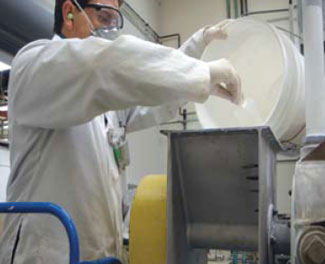
 |
|||
NIOSH Publication No. 2008-112:Safe Nanotechnology in the Workplace |
February 2008 |
|
| ||||||||||||||||||
| Introduction | |
| 1. Are nanoparticles hazardous to workers? | |
| 3. Can nanoparticles be measured? | |
| 4. Can worker exposures be controlled? | |
| Where can I get more information? |
Nanotechnology is the engineering and manipulation of materials at the molecular level. This new technology creates materials with dimensions ranging from 1 to 100 nanometers (1 nanometer is 1 billionth of a meter). Particles created at the nanoscale have different chemical and physical properties than larger particles of the same material. These manufactured nanoparticles are known as engineered nanoparticles.* Scientists and manufacturers can use nanoparticles to create new products that would be impossible with larger particles.
This brochure addresses the following questions:
* Engineered nanoparticles are referred to as nanoparticles throughout this brochure.
Little information is available about the hazards of nanoparticles in the workplace. The National Institute for Occupational Safety and Health (NIOSH) is conducting research to determine whether they pose a health threat to exposed workers.
Different types of nanoparticles are made or used in various industrial processes. To determine whether these nanoparticles pose a hazard to workers, scientists must know the following:

A nanoparticle production worker wearing a personal air
sampler and hearing, respiratory, and dermal protection
during a pouring operation.
Effects in animals. Laboratory studies in animals have shown that some types of nanoparticles may reach the blood, brain, and other organs of laboratory animals when they are inhaled. Some studies have shown adverse effects such as inflammation and fibrosis in the lungs and other organs of animals.
Effects in humans. Human studies of exposure and response to engineered nanoparticles are not currently available.
Safety issues in the workplace. Fire and explosion are the main safety hazards associated with nanoparticles in the workplace. Some materials at the nanometer scale may unexpectedly become chemical catalysts and result in unanticipated reactions.
Current exposure standards. No U.S. or international exposure standards have been established for nanoparticles.
Recommendations. Although more research is needed to predict the effects of nanoparticle exposures in humans, sufficient information is available to provide interim recommendations and guidance about occupational exposures to nanoparticles. NIOSH recommends a prudent approach for manufacturing and using nanoparticles in industry. Employers should take steps to minimize worker exposures until more information is available.
Workers may be exposed by three routes:
Inhalation—The most common route of exposure is by inhalation.
Ingestion—Workers can be exposed by unintentional hand-to-mouth transfer of materials or swallowing particles cleared from the respiratory tract.
Skin—Some studies mention that nanoparticles may penetrate the skin. This possibility is being investigated.
Traditional industrial hygiene sampling methods can be used to measure airborne nanoparticles. However, these methods are limited and require careful interpretation. Scientists are developing more sensitive and specific sampling techniques to evaluate occupational exposures to nanoparticles.
Sampling in the workplace should include background measurements and measurements before, during, and after production or handling of nanoparticles. These measurements can determine if emissions and possible exposures are occurring.
Engineering controls. Employers should use engineering controls to reduce worker exposures to nanoparticles. These controls include source enclosure (isolating the generation source from the worker) and local exhaust ventilation systems. Exhaust ventilation systems that use high-efficiency particulate air (HEPA) filters are very effective in removing nanoparticles.
Engineering controls have been designed to reduce worker exposures to other particles with sizes similar to those of nanoparticles. Examples include controls for welding fume. These controls are also effective for the manufacturing and fabrication of nanoparticles.
Respirators. Respirators should be considered if engineering and administrative controls do not control worker exposures to nanoparticles. The decision to use respirators should be based on professional judgment and an assessment of worker exposures and the health risks they pose.
Training. Worker training should be part of any complete safety and health program. To reduce nanoparticle exposures, workers should learn how to safely handle nanoparticles, use personal protective equipment, handle work clothes, clean contaminated surfaces, and dispose of spilled nanoparticles.
Refer to the following sources for more information about safe nanotechnology in the workplace:
Approaches to Safe Nanotechnology: An Information Exchange with NIOSH [www.cdc.gov/niosh/topics/nanotech/safenano/]
NIOSH Nanotechnology Website: www.cdc.gov/niosh/topics/nanotech/
NIOSH
Telephone: 1–800–CDC–INFO (1–800–232–4636)
TTY: 1–800–232–6348
E-mail: cdcinfo@cdc.gov
or visit the NIOSH Web site at www.cdc.gov/niosh
For a monthly update on news at NIOSH, subscribe to NIOSH eNews by visiting www.cdc.gov/niosh/eNews
For general information about nanotechnology, visit www.nano.gov
DHHS (NIOSH) Publication No. 2008–112
February 2008
Photo Credits: Nanotrees, Ghim Wei Ho and Professor Mark Welland, Nanostructure Center, University of Cambridge
|
2008-112.pdf The free Adobe Acrobat Reader is needed to view this file. |